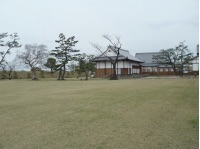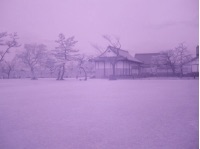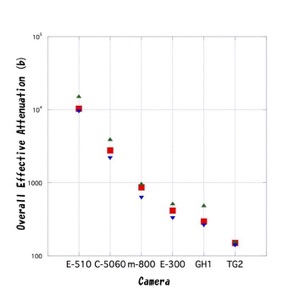Atelier Bonryu(E)
infrared photography


Atelier Bonryu(E)
infrared photography


Laboratory: Infrared Photography
Taking Infrared Photographs
2-3 IR Sensitivity of Non-converted Camera
Sensitivity of Non-converted Digital Camera to Take Infrared Photograph: As a commercially available digital camera (an IR non-converted camera) is not put out for the purpose of the infrared photography, its technical data on the infrared photography such as the sensitivity of the sensor to the infrared lights are not usually made public by the manufacturer. It is interesting and important to know how much the overall sensitivity of a digital camera suffers deterioration when we take an infrared photograph by using a visibly opaque and infrared transparent external filter unless the internal IR filter is removed. Though some measuring devices are necessary to know the sensitivity for the infrared light quantitatively, we can estimate very roughly the relative value of the sensitivity of the infrared light compared to that of the visible light, by taking a visible light photograph and an infrared photograph of a same object by a same camera and by comparing the photographing data as described in the following. In this way the sensitivity to the infrared light was roughly estimated for several non-converted cameras.
Needless to say a digital camera with lower b has higher sensitivity for IR lights. As an example one set of photographs of visible and infrared lights among 30 sets of photographs used for the estimation is shown below (Fig.2-7). As described previously it should be remarked that the measurements have not been carried out under a strictly controlled conditions (correct exposure). Especially, the shutter speed and the f-value should be chosen so that the “optimum” picture is realized, but it is difficult to define the “optimum” picture and we chose a prettyish picture subjectively as the “optimum” picture by visual evaluation. Therefore, there is considerable degree of errors in F and T, but it may be safe to say that in sequence of E-510, C-5060W, mu Digital 800, E-300, GH1, and TG-2 the sensitivity to IR lights improves.


Fig.2-7 Photographs used for the estimate of the IR sensitivity (example)
Saga castle main vein museum of history (mu digital 800)
<=Visible light photograph
(F=23.5, T=1/640, ISO=64)
IR light photograph=>
(F=2.8, T=1/2, ISO=125)




Sensitivity Measurement: The purpose of this measurement is to determine the value of (1/b) which is the relative sensitivity of the infrared light compared to the visible light. The value of b is the overall effective attenuation ratio for the infrared light and it is, of course, more than unity. For this purpose it is necessary to take an infrared and a visible light photographs of the same object by the same camera under the “correct exposure”. But as it is difficult to define what is the “correct exposure” in our measurement we fix up to be satisfied as the photograph is taken under a correct exposure if it looks sightly. For these two photographs we write down the photographing parameters, i.e., the f-value (F), the shutter speed (T), and the ISO setting value (I).
The overall effective attenuation ratio, i.e., the necessary multiplication factor for the exposure to the infrared photography, b, is expressed (Remark #3 ) as,

where the suffices v and ir denote values for the visible and infrared lights, respectively.
In this section the sensitivity of a non-converted camera to the infrared light is explained. There are many cameras with sufficiently high sensitivity and directly usable for the infrared photography even if they are not converted.

Fig.2-6 The overall effective attenuation for the infrared light (The necessary multiplication factor of the exposure)
The result of measurements for 6 digital cameras is obtained by taking 5 sets of infrared and visible light photographs. The maximum, the minimum and the mean values are plotted for each camera.
Figure 2-6 shows the measured overall effective attenuation ratio for several non-converted digital cameras under my hand, i.e., Olympus E-510, Olympus Camedia 5060W, Olympus mu digital 800, Olympus E-300, Panasonic Lumix GH1, and Olympus TG-2. The same data are summarized as a table (Table 2-1), where the release date of each camera is also inserted and it is found that as long as the cameras in this table recently released cameras are more sensitive to the infrared light and it is easier to take an infrared photograph by these cameras.

Table 2-1 Necessary multiplication factor of exposure of unconverted cameras
From the above figure, for example, it is found that the effective attenuation b of E-300 is about 500 and, therefore, for an object of a visible light photograph taken by the ISO setting of 100 and T=1/250 sec an infrared photograph is taken by the ISO setting of 400 and T=1/2 sec.
By the way the first camera I used for the digital infrared photography was Olympus E-510. The reason was that I would like to use an SLR camera for the infrared photography but those days there were few SLR (Single Lens Reflex) cameras with a live view screen as the Olympus E-510. Needless to say if a visibly opaque filter is put in front of a taking lens one cannot take sight through the optical finder of an SLR camera. However, recently a single lens mirrorless camera becomes more popular than an SLR camera. As in the mirrorless camera an optical finder is not used and an electronically represented image of an object in the finder is the same image as on the sensor, the mirrorless camera is better suited for the infrared photography.
